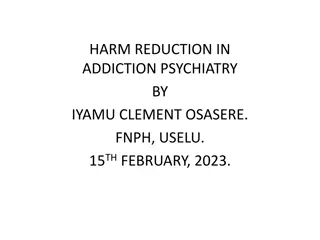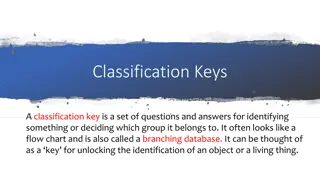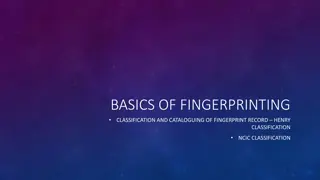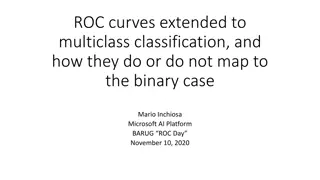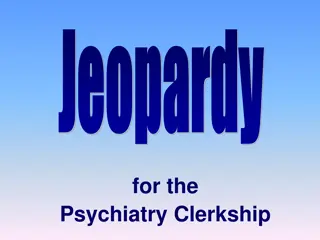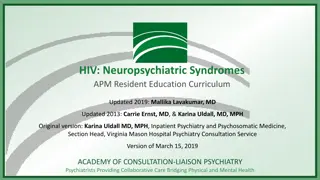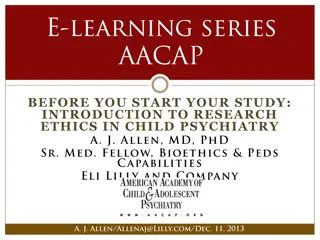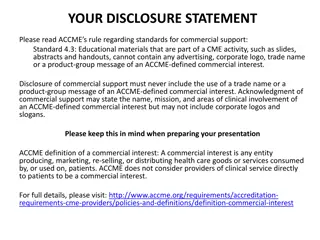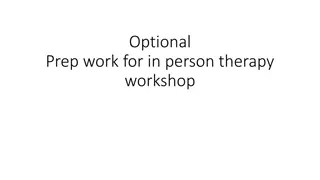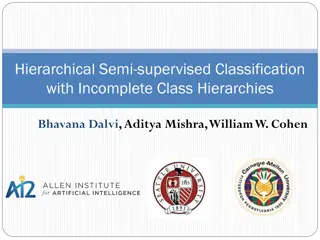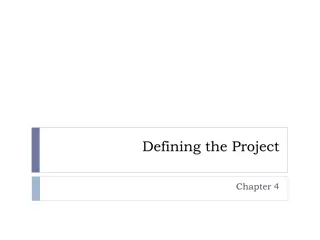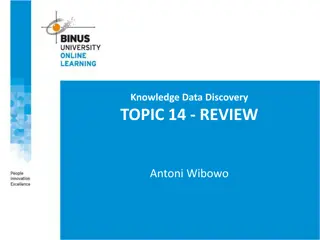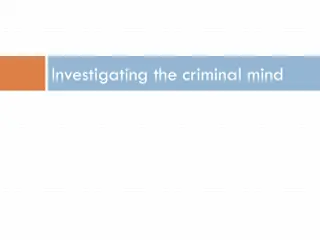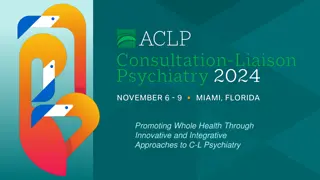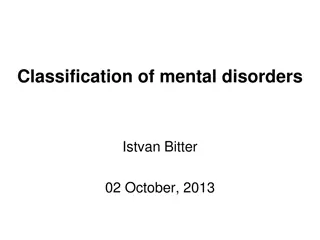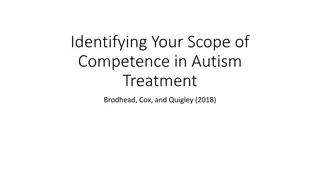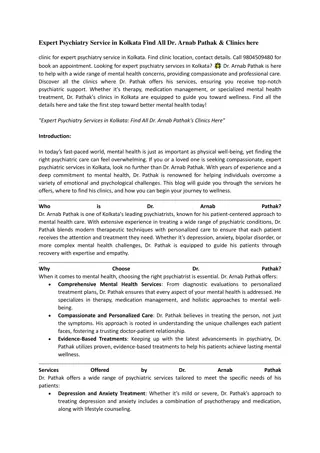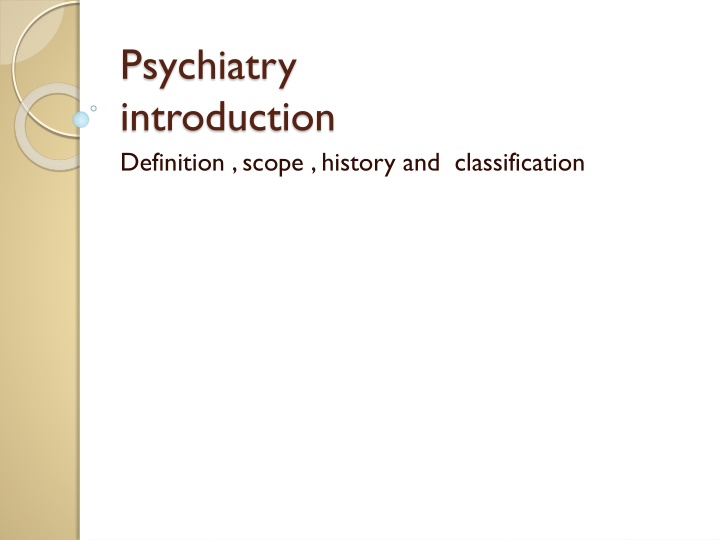
Psychiatry Introduction: Definition, Scope, History, Classification
This content delves into the field of psychiatry, covering its definition, scope, historical evolution, and classification of mental disorders. Explore the origins of psychiatry, basic terms, epidemiology, and services provided. Discover key terms like psychiatric disorder, psychological disorder, mental disorder, factors of illness, and prevalent services. Trace the history of psychiatry from ancient civilizations to modern practices, including significant figures and milestones.
Download Presentation

Please find below an Image/Link to download the presentation.
The content on the website is provided AS IS for your information and personal use only. It may not be sold, licensed, or shared on other websites without obtaining consent from the author. If you encounter any issues during the download, it is possible that the publisher has removed the file from their server.
You are allowed to download the files provided on this website for personal or commercial use, subject to the condition that they are used lawfully. All files are the property of their respective owners.
The content on the website is provided AS IS for your information and personal use only. It may not be sold, licensed, or shared on other websites without obtaining consent from the author.
E N D
Presentation Transcript
Psychiatry introduction Definition , scope , history and classification
Psychiatry Lecturer Assistant Professor Uday Khalid udaykhalid@yahoo.com udaykhalid@ colmed.nahrainuniv.edu.iq http://colmed.nahrainuniv.edu.iq/ References Davidson's clinical practice of medicine Oxford short textbook of psychiatry
Psychiatry Aims help student to be familiar with origin and evolution of the field get idea about terms , scope ,and epidemiology , , services and classification of mental disorders Objectives learn how psychiatry evolved learn basic terms in the field know basic knowledge about epidemiology , services and classification
Psychiatry Definition Terms Psychiatric disorder Psychological disorder Mental disorder
Psychiatry , Factors of illness Biological Psychological Social Biopsychosocial
Psychiatry Terms further Psychiatrist Psychologist Social worker
Psychiatry Prevalence Services asylum outpatient and primary health care referral system N.B. Stigma
Psychiatry History History of psychiatry is history of humanity Ancient Greece , Egypt , Mesopotamia , Rome ,India super nature , exorcism Hippocrates four humors dissection
Psychiatry Middle ages Europe dark ages , exorcism Middle ages East Averroes , Rhazis , Avicenna Bimaristans first mental hospitals in history
Psychiatry Dark ages East exorcism Enlightenment Europe modern psychiatry
Psychiatry Neuroses Sigmund Freud Psychoses Kraepline , Schneider , Blueler
Classification of mental illness History of Classification of Mental Disorders Emil Kraepline Psychoses Dementia Precox (Schizophrenia) Manic depressive psychosis
Classification of mental illness Kurt Shieder First Rank Symptoms Eugene Blueler group of schizophrenias Autism Avolition Affect blunting Ambivalence
Classification of mental illness Sigmund Freud Neuroses Actual neurosis anxiety Psychoneuroses hysteria , obsessive compulsive neurosis
Classification of mental illness PsychosisVs.Neurosis Severity Suffering Insight
Classification of mental illness Organic Vs. Functional Organic organic pathology Functional absence of morbid pathology
Classification of mental illness Syndrome definition Two major Classification Systems International classification of Disease ICD-10 Diagnostic and statistical Manual DSM V
Classification of mental illness International classification of disease ICD-10 Diagnostic and statistical manual DSM - IV *Organic mental disorders *Dementia delirium amnesic disorder and other cognitive syndromes Psychoactive substance use disorders Schizophrenia Mood disorders Anxiety disorders Generalized Phobias Panic *Psychoactive substance use disorders *Schizophrenia *Mood disorders *Neurotic disorders Anxiety disorders Generalized Phobias Panic Conversion disorders *Conversion disorders * dissociate disorders Somatoform disorders Somatization Hypochondriasis *Stress related disorders Acute PTSD Adjustment disorders Somatoform disorders Somatization hypochondriasis Stress related disorders Acute PTSD Adjustment disorders *Syndromes with physiological Disturbance Eating Sleep Sexual dysfunctions Puerperium *Adult personality and behavior Personality Sexual orientation and preference *Mental retardation *disorders of psychological development specific pervasive *childhood syndromes hyperkinetic disorders conduct disorders emotional disorders *Eating Sleep Purperium Sexual disorders personality learning disability disorders of psychological development specific pervasive *childhood syndromes hyperkinetic disorders conduct disorders emotional disorders
Classification of mental illness Depression & Depressive Disorders Anxiety Disorders & Phobias Bipolar & Related Disorders Schizophrenia & Psychotic Disorders Attention Deficit Hyperactivity Disorder (ADHD) Addiction, Substance-Related Disorders & Alcoholism PTSD, Trauma & Stress-Related Disorders Feeding & Eating Disorders Obsessive-Compulsive and Related Disorders Dissociative Disorders Somatic Symptom and Related Disorders Personality Disorders (Axis II) Sleep-Wake Disorders Sexual Dysfunctions Disruptive, Impulse-Control, and Conduct Disorders Neurocognitive Disorders
Classification of mental illness Concept of mental illness Statistical Cultural Morbid Pathological criteria
Psychiatry Lecturer Assistant Professor Uday Khalid udaykhalid@yahoo.com udaykhalid@ colmed.nahrainuniv.edu.iq http://colmed.nahrainuniv.edu.iq/ References Davidson's clinical practice of medicine Oxford short textbook of psychiatry
Psychopathology Aims provide an outline of types provide an outline of descriptive psychopathology Objectives students know and define types they know aspects of descriptive one know terms and definitions of common phenomena in practice
Psychopathology Psychopathology Descriptive form and content Etiological
Psychopathology Disorders of appearance and behavior Disorders of speech Disorders of thinking Disorders of perception Disorders of emotion Disorders of cognitive (intellectual) functions Disorders of experience of self
Appearance and Behavior Dress Cleanness Self care Facial expression Activity Attitude Eye contact Movements tics , chorea , athetosis , echopraxia , waxy flexibility
Disorders of speech Rate Slow Rapid Relevance Incoherence Neologisms
Disorders of thinking form retardation fast others schizophrenic formal disorders lack of association content preoccupation obsession delusion N/B overvalued idea
Disorders of thinking Delusions primary sudden delusional idea delusional perception delusional memory secondary paranoid , persecutory , grandiose , jealousy , love , somatic , poverty , nihilistic
Disorders of perception illusion hallucination auditory simple , complex 3rdperson ,commentary, echo visual olfactory gustatory tactile proprioceptive ** pseudo hallucinations
Disorders of emotion abnormal emotional reaction apprehension phobia sadness , depression happiness ,elation , exaltation, ecstasy, euphoria apathy irritability suspiciousness
Disorders of emotion abnormal expression lability emotional incontinence blunting incongruity perplexity ambivalence
Cognitive disorders Attention Concentration Memory immediate , recent , long term Intelligence Insight Derealiation / depersonalization dejavu : , jamais vu:
Boundaries of self Alienation thought withdrawal thought insertion thought broadcasting Passivity made act , made feeling , made impulse made somatic sensation

